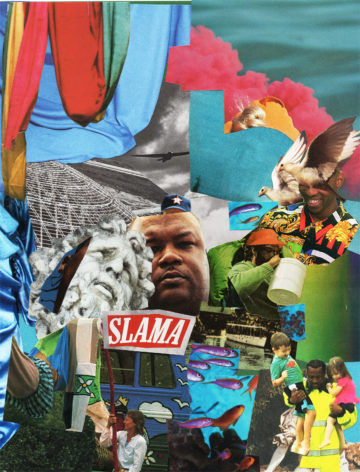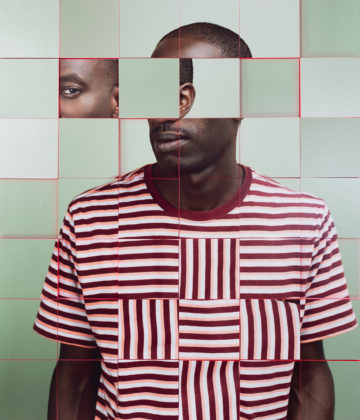The late, great DJ Screw, born Robert Earl Davis Jr., sold mixtapes in high school for lunch money. He went on to open his own record store—the legendary Screwed Up Records & Tapes—sell hundreds of thousands of copies of his albums, and establish himself as the godfather of Houston hip-hop, all before his untimely death in 2000 from a codeine overdose at 29. Now, a new exhibit at the Contemporary Arts Museum Houston, Slowed and Throwed: Records of the City Through Mutated Lenses, explores his artistic legacy. His lunch money mixtapes didn’t have the same sound for which he would become known; Big Bubb, Screw’s cousin and the current owner of Screwed Up Records & Tapes, says as much in a documentary filmed for the exhibit. At that point, he was still experimenting, becoming the artist Houston knows and loves.
By slowing, chopping, and incorporating freestyles from other artists in the Screwed Up Click—his collective of 29 Houston rappers—Screw fractured others’ beats into a sound particular to his time and place. Mimicking the effects of lean—a potent mixture of codeine cough syrup and soda, usually Sprite—Screw tapes bump along at a sedate pace, warping the track’s voices and beat. The style earned him the nickname “The Originator.” Big Bubb puts it simply: “He was the sound of Houston … Screw would take songs that you didn’t like and put them in a mix and make you love them.”

The exhibit, open now through June 7, excels in spotlighting small, intimate details alongside Screw’s broader mythology. More than 30 artifacts, not including the music playing on loop, map his path to becoming a renowned artist. Photos of the musician in his Little League uniform sit not far from a facsimile of the Screwed Up Bible, which chronicles Screw’s 343 mixtapes, or “chapters,” that he produced (Big Bubb and other members of the Screwed Up Click are still finding new chapters). Stories, on placards and in the documentary, show how it was practically impossible to tear Screw from a record store—“just prepare,” said Screwed Up Click member Will-Lean, because “you ain’t doing nothing for the rest of the day.”
Hung above placards of friends’ personal accounts, record store receipts, and notes in Screw’s rushed handwriting, DJ Screw in Heaven (2008), painted by Houston artist El Franco Lee II, depicts Screw standing over his famous dual turntable setup. Behind him are other deceased members of the Screwed Up Click, most of whom are sipping lean out of styrofoam cups. But in the heaven El Franco depicts, Screw, like a Hindu god, has six arms, five of which he uses to manipulate the turntable and one he uses to pass a blunt.
Slowed and Throwed is an attempt to recognize Screw in a canon of high artistic expression, an exhibition “30 years in the making,” according to Museum Director Hesse McGraw. “Screw is an avant-garde composer,” said curator Patricia Restrepo at the opening night party. The archives—collected and organized with the help of July Grob of the Houston Hip Hop Research Collection at the University of Houston; Big Bubb; E.S.G., rapper and member of the Screwed Up Click; and Rocky Rockett, independent hip hop educator—are housed in a replica of the original location of Screwed Up Records & Tapes. Surrounding the archives in the circular chamber outside is the second part of the exhibition: the works of 15 other Houston-based or Houston-affiliated mixed media artists who, in their own way, are producing “chopped and screwed” art.
The exhibit defines chopped and screwed art loosely, broadening the term to include any media that is repurposed or reclaimed. This includes collage, like the works by Robert Hodge, whose canvases are covered with pictures from vinyl album covers. Other artists blend YouTube videos with written words, or cassette recordings with live music. Every participating artist—or “visual DJ,” as Restrepo calls them—adds found objects or audio or videos together to create something new, an expression of the self.

Sondra Perry’s video “Suspicious Glorious Absence” combines spliced home bodycam footage with racist news clips, depictions of police brutality and protests, and advertisements for mass-surveillance technology. The piece juxtaposes the home and the family with a society bent on criminalizing black and brown bodies. Ann Johnson’s sculpture “Plantation Song” places a swath of raw cotton inside the metal outline of a trumpet. On the cotton, Johnson has printed an image of a black man, invoking the United States’ long history of white communities stealing and repackaging black music.
There’s also Liss LaFleur’s “Don’t Worry Baby,” a video featuring a slowed-down lip-sync of The Beach Boys’ 1964 pop song. The video projects onto staggered sheets of string, splintering the image as the light seeps through the cracks of each layer and hits the wall. LaFleur, a queer woman, appropriates a song originally written and performed by cis men to express her love in contrast to its original heterosexual intention. Much like Screw, whose repurposed audio samples came from record studios with far more resources than he had, LaFleur’s cover redefines the logic of the song and expresses her particular experience.
DJ Screw’s work could never be taken for anything other than an underground project—he was content creating music that united black and brown communities on Houston’s South Side. The worldwide effect he had on rap music was a happy accident, a testament to his creative vision. He and the Screwed Up Click took agency on their own and created a new avenue in Houston for musical success. The collaborative work of Slowed and Throwed demonstrates just how deeply others feel his legacy in music and art and the intersection between the two.
Read more from the Observer:
-
Coronavirus is Exposing the Faulty Foundations of the Texas Fracking Industry: The oil and gas sector was already having problems, but the fear and uncertainty around a global pandemic could end the Texas energy boom.
-
U.S. Supreme Court Sides with Trump Administration on ‘Remain in Mexico’: Following weeks of back-and-forth in the courts, SCOTUS has reversed the decision of an appeals court and allowed Remain in Mexico to continue.
-
How Christian Nationalism Moved from the Fringe to the White House: Katherine Stewart’s The Power Worshippers exposes the Christian right’s attempts to revise history and create an American theocracy.







